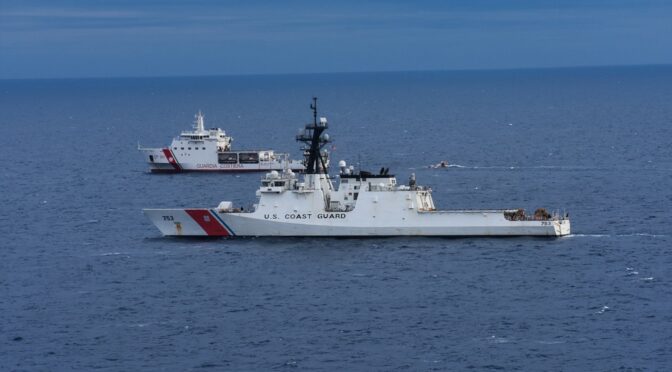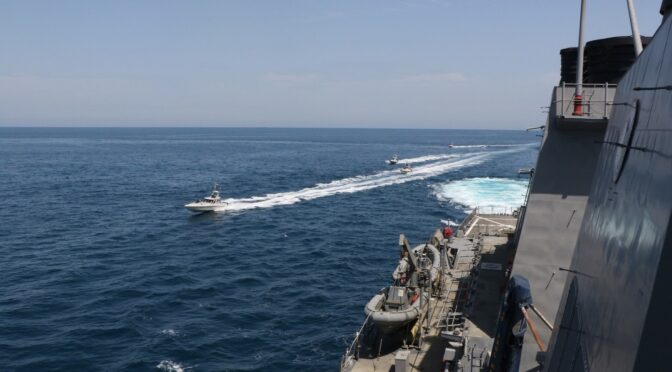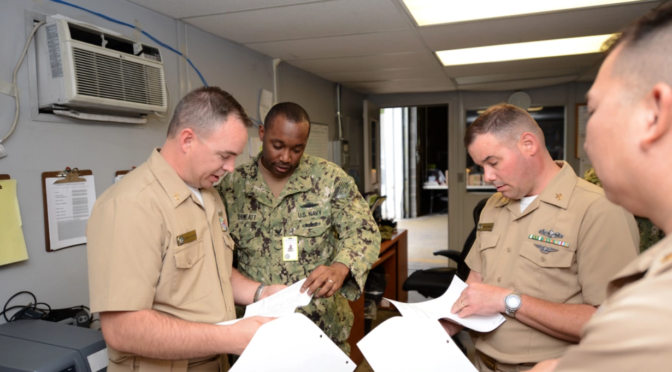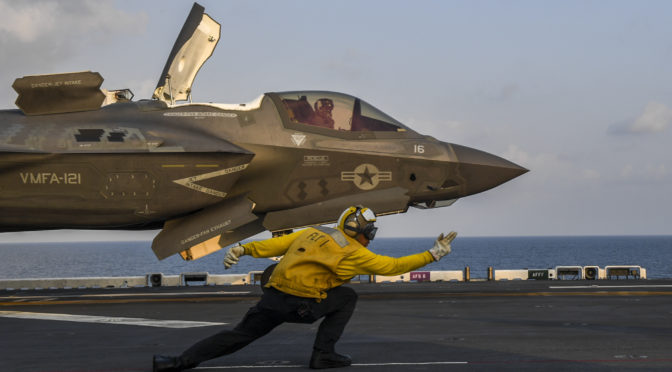By Thomas “Buddy” Bardenwerper
This is part two of an article posted on November 8, 2021. The first installment provided an overview of the U.S. Coast Guard’s counter-maritime drug trafficking mission and analyzed the extraterritorial jurisdiction created by the Maritime Drug Law Enforcement Act. This installment discusses the prolonged detention of suspected smugglers aboard Coast Guard cutters and the interaction between intelligence gathering and the trial penalty during prosecution.
Lengthy Detentions and Federal Rule of Criminal Procedure 5(a)
Once the Coast Guard has made a successful drug interdiction, the smugglers are embarked upon the patrolling Coast Guard cutter as detainees. Rarely, if ever, will these individuals be formally placed under arrest while at sea, meaning they will neither be read their Miranda rights nor interrogated. It is not until detainees are disembarked on U.S. soil – days or weeks later – that they are formally placed under arrest, usually by Drug Enforcement Administration (DEA) or Homeland Security Investigations (HSI) agents. Delaying formal arrest avoids the Fed. Rule of Crim. Procedure 5(a)(1)(B) requirement that “a person making an arrest outside the United States must take the defendant without unnecessary delay before a magistrate judge, unless a statute provides otherwise.”1
Lengthy Detentions
These prolonged detentions have come under considerable scrutiny in recent years. Most notably, the New York Times Magazine chronicled how, in a span of six years, “more than 2,700 men […] have been taken from boats suspected of smuggling Colombian cocaine to Central America, to be carried around the ocean for weeks or months as the American ships continue their patrols.”2 These decisions regarding where and when to transfer detainees ashore are not solely left to the discretion of the Coast Guard, however, but are instead made by the Department of Justice and its subordinate agencies.3 These organizations justify the long detention periods by pointing out the logistical hurdles associated with patrolling over six million square miles of ocean and the fact that most Latin American countries do not allow air transfer of detainees to the United States. If the U.S. government is serious about combating the unrelenting flow of northbound cocaine with only a handful of Coast Guard cutters deployed at any given time, such assets cannot be taken out of the fight for several days just to transit one smuggling crew to port.
Defendants have had little success challenging the legality of their extended stays aboard Coast Guard cutters. In United States v. Cabezas-Montano, the Eleventh Circuit denied an Ecuadorian national’s argument that the 49-day delay between his initial detention in the eastern Pacific and his presentment before a magistrate in Florida violated both Fed. Rule Crim. Pro. 5(a) and the Fourth Amendment right to a probable cause determination.4 As to the first claim, the court noted that “various factors are considered in determining whether a delay was unnecessary, including: (1) the distance between the location of the defendant’s arrest in international waters and the U.S. port he was brought to; (2) the time between the defendant’s arrival at the U.S. port and his presentment to the magistrate judge; (3) any evidence of mistreatment or improper interrogation during the delay; and (4) any reason for the delay, like exigent circumstances or emergencies.”5 Because (1) the distance from the Pacific coast of Guatemala to Florida was “quite lengthy;” (2) there was only a one-day delay between the detainee’s arrival in Key West and presentment before a magistrate; and (3) there was no evidence of mistreatment or interrogation, the defendant “failed to carry his burden that the particular delay here was ‘unnecessary’ and thus a [Fed. Rule Crim. Pro.] 5(a) violation.”6 The court also dismissed the Fourth Amendment claim since such protection “does not apply to searches and seizures (arrests) by the United States of a non-citizen/non-resident alien arrested in international waters or a foreign country.”7
Possible Forum Shopping
Some believe that the Coast Guard’s practice of transporting detained smugglers vast distances – and in some cases through the Panama Canal – to the government-friendly Eleventh Circuit amounts to impermissible forum shopping. In Cabezas-Montano, however, the Eleventh Circuit denied the defendant’s claim “that the government purposely delayed his presentment to a magistrate judge in order to forum shop because federal courts in California require the government to prove a U.S. ‘nexus’ to establish subject-matter jurisdiction, whereas Florida courts do not.”8 According to the court, even if such an incentive existed, “The MDLEA does not prohibit the government from taking offenders to Florida rather than California [because] a person violating the MDLEA ‘may be tried in any district,’ ‘if the offense was begun or committed upon the high seas.’”9
The government fended off an even stronger allegation of forum shopping in Alvarez-Cuan v. United States, a Middle District of Florida case in which a smuggler challenged his MDLEA conviction. Alvarez-Cuan argued that he should have been tried in the District of Puerto Rico vice the Middle District of Florida since a Coast Guard cutter upon which he was embarked pulled into port in San Juan before his eventual transfer ashore in Tampa.10 The court denied his motion on procedural grounds, but noted that the jurisdictional claim was without merit since the MDLEA “makes clear […] that the accused may be tried in any district.”11 In arriving at this conclusion, the court cited precedent in United States v. Gonzales-Cahvec.
In Gonzales-Cahvec, the Eleventh Circuit held that the MDLEA’s forum provision was properly grounded in Art. III, Sec. 2 of the Constitution, which states that when a crime is “not committed within any State, the Trial shall be at such Place or Places as the Congress may by Law have directed.”12 However, the Eleventh Circuit went on to say that jurisdiction over Gonzales-Cahvec was properly established in the Southern District of Florida because that is where he “first entered the United States.”13 While seemingly sensible, this logic does not support the Middle District of Florida’s ruling in Alvarez-Cuan—the prior case—because Alvarez-Cuan “first entered the United States” in the District of Puerto Rico when the cutter transited U.S. territorial seas on its way to the pier in San Juan. Or perhaps the cases are distinguishable because Alvarez-Cuan was not physically transferred ashore? The Middle District of Florida did not say.
Detention Takeaways
For the time being, the Coast Guard’s dual practices of lengthy smuggler detention and government-friendly venue selection seem resilient to legal attack. Lengthy detentions will likely continue to stand – unless they are particularly egregious – because judges know that the maritime counter-drug mission would be logistically impossible if cutters had to rush detainees ashore after every interdiction. Convenient forum selection will likely continue to stand because the only judges and justices who can deem such a practice unlawful sit on either the government-friendly Eleventh Circuit or the majority conservative Supreme Court. However, while the government in general and the Coast Guard in particular benefit from this status quo, both entities would do well to develop long range contingency plans in the event that the judiciary someday changes course.
Intelligence, Prosecution, and the Sixth Amendment
When Coast Guard cutters patrol the eastern Pacific and Caribbean for drug smugglers, they are not operating blindly thanks to Joint Interagency Task Force – South (JIATF-S),14 a “multi-agency, international alliance [based out of Key West] whose mission is to cover 42 million square miles of territory primarily in Central and South America to stem the flow of illegal drugs and to disrupt and dismantle sophisticated narco-trafficking networks.”15 While the actual mechanics of JIATF-S’s mission execution are classified, suffice it to say that JIATF-S collects intelligence from its federal and international component organizations; evaluates and synthesizes this information; and briefs operational units. The Coast Guard cutters in theater will then coordinate with their shoreside command centers to determine – in conjunction with Coast Guard, Navy, and CBP surveillance aircraft – which smuggling ventures to target for interdiction.16
Much of the actionable intelligence that powers JIATF-S originates from domestic and overseas DEA, HSI, and FBI investigations, as well as cooperation agreements brokered by federal prosecutors. The U.S. Attorney’s Office for the Middle District of Florida has played a leading role in these efforts through its Organized Crime and Drug Enforcement Task Force (OCDETF) known as Operation Panama Express. As of 2016, Operation Panama Express had a conviction rate of 97 percent and sentences averaging over ten years.17 With this track record, it is unsurprising that so many MDLEA offenders are tried in the Middle District of Florida. But more important from a law enforcement perspective is the intelligence that these prosecutions produce, intelligence that has contributed to the arrest and extradition of a majority of all Colombian Consolidated Priority Organizational Targets, or “drug kingpins,”18 not to mention hundreds of additional low-level maritime drug smugglers.
Trial Penalty
Operation Panama Express – like any U.S. Attorney’s Office – gathers intelligence by making deals with defendants awaiting trial. In exchange for a defendant’s cooperation and guilty plea, the prosecution will recommend a lesser sentence to the trial judge. This process is largely made possible by the threat of a “trial penalty,” which is the “substantial difference between the sentence offered in a plea offer prior to trial versus the sentence a defendant receives after trial.”19 Other than winning at trial, the only way for an MDLEA defendant to avoid the 21 U.S.C. § 960 ten-year mandatory minimum is to cooperate 20 because “the court has authority to sentence below the mandatory minimum only upon a government motion based upon the defendant’s ‘substantial assistance’ to the prosecution.”21 Under this legal regime, “the prosecutor holds the key to the jailhouse door,”22 and the pressure upon a defendant to forego his Sixth Amendment right to trial can be overwhelming.
This practice of leveraging mandatory minimums to compel defendants to waive their Sixth Amendment right to trial and cooperate is not unique to MDLEA prosecutions. However, the practice is especially effective in the MDLEA context since these defendants are at a particular disadvantage should they go to trial. First, with the exception of co-defendants, there are rarely any firsthand witnesses to refute the testimony of law enforcement. Second, the U.S. government expends its limited resources on prosecuting only the most clear-cut cases. And third, these prosecutions can be so repetitive that desensitized judicial actors in venues like the Middle District of Florida may overlook weaknesses in the government’s case. Really, there exists only one long-shot defense, and that is to attack the court’s subject matter or personal jurisdiction, as seen in the discussion in Part One about extraterritoriality.
Just because many defendants will knowingly and willfully plead guilty in the face of these unfavorable conditions does not make the practice uncontroversial. According to the National Association of Criminal Defense Lawyers, less than three percent of criminal prosecutions go to trial.23 As Judge John Gleeson writes, using mandatory minimum sentences not for their intended purpose of “impos[ing] harsher punishments on a select group of the most culpable defendants,” but rather to “strong-arm guilty pleas, and to punish those who have the temerity to exercise their right to trial” undermines “the integrity of our criminal justice system.”24 First, the risk of losing trial and facing an enormous sentence will compel even innocent defendants to plead guilty; and second, even culpable defendants are deprived of their Sixth Amendment right to force the government to prove its case beyond a reasonable doubt.25
Safety Valve Relief
Looking forward, however, there may be one other way for suspected drug smugglers to avoid the ten-year minimum sentence associated with MDLEA convictions. A circuit split has developed with the D.C. Circuit now recognizing the applicability of 18 U.S.C. §3553 “safety valve” relief to defendants convicted of MDLEA violations. This legislation “permits a sentencing court to disregard a statutory minimum sentence for the benefit of a low-level, nonviolent, cooperative defendant with a minimal prior criminal record, convicted under several mandatory minimum controlled substance offenses.”26 In United States v. Mosquera-Murillo, the D.C. Circuit extended safety valve relief to appellants previously convicted of violating the MDLEA even though the MDLEA is not “‘an offense under’ any of [18 U.S.C. §3553(f)’s] five enumerated [controlled substance] provisions.”27 The court reasoned that the appellants were eligible for relief nonetheless since MDLEA defendants are sentenced pursuant to 21 U.S.C. § 960 – which is one of the safety valve’s “five enumerated provisions.”28
Because the D.C. Circuit handles so few MDLEA prosecutions, it is unclear what practical effect – if any – its holding will have on the vast majority of defendants. The Eleventh Circuit, for example, still precludes such defendants from invoking safety valve relief. In United States v. Valois, the court held that just because safety valve relief is “available to [non-MDLEA] defendants convicted of drug trafficking within the United States,” the safety valve’s exclusion of MDLEA defendants “does not violate the equal-protection guarantee of the Fifth Amendment.”29 The court justified this holding through rational basis review, saying that “Congress had ‘legitimate reasons to craft strict sentences for violations of [the MDLEA],’” reasons that included “concerns about foreign relations and global obligations” as well as the need to deter “drug trafficking on the vast expanses of international waters.”30
The Ninth and First Circuits agree. Despite its pro-defendant understandings of other aspects of the MDLEA, the Ninth Circuit – using the expressio unius canon of construction – has held that “the plain statutory language indicates that the safety valve provision in 18 U.S.C. § 3553(f) does not apply to violations of [the MDLEA].”31 While the First Circuit has not “addressed directly whether a defendant convicted of an MDLEA offense is eligible for safety valve relief,” the District of Puerto Rico recently reiterated that “MDLEA offenses are not section 960 offenses” because Congress repeatedly “omitted MDLEA offenses from section 960” during multiple revisions of the latter statute.32 However, it should be noted that this case is pending appeal. Therefore, until the case law changes in any of these circuits, the vast majority of MDLEA defendants will remain ineligible for safety valve relief.
Trial Penalty and Relief Takeaways
Just as the government has pushed the bounds of extraterritoriality and due process, it has also pushed the bounds of a defendant’s Sixth Amendment right to trial by leveraging the trial penalty to induce guilty pleas and cooperation. This strategy is not unique to maritime law enforcement, but it is particularly effective in relation to this mission. Given the vast swaths of ocean that a small number of Coast Guard assets patrol, intelligence gained through defendant cooperation is vital in positioning these cutters in the right place at the right time. While other circuits may eventually follow the D.C. Circuit’s lead with regards to extending safety valve relief to MDLEA defendants, such a change is unlikely to alter the dynamics of the maritime counter-drug mission. However, should there be a national push against the use of the trial penalty to compel cooperation in all criminal cases, law enforcement would suddenly find itself operating blindly in the ongoing struggle against maritime drug smuggling.
Conclusion
All three branches of the U.S. government have helped create a maritime law enforcement apparatus specially designed to combat the trafficking of South American cocaine. The executive has contributed an aggressive and proficient Coast Guard; the legislature has produced the MDLEA; and the judiciary has provided government-friendly interpretations of statutes and the Constitution. Of these three legs that support the struggle against maritime drug smuggling, the most fragile is the last. Should judicial opinion shift regarding the legality of (1) the MDLEA’s extraterritorial jurisdiction; (2) the prolonged detentions of smugglers aboard Coast Guard cutters and their prosecutions in geographically far-flung judicial districts; or (3) the use of the trial penalty to compel guilty pleas and cooperation, the struggle against maritime drug smuggling will fundamentally change. A more narrowly tailored MDLEA would result in the contraction of de-facto U.S. maritime borders and/or a reduction in the categories of vessels that the Coast Guard could target. A less permissive approach to prolonged detentions would lead to less efficient Coast Guard patrols. And, finally, a rejection of the trial penalty would foreclose valuable sources of intelligence.
It is tempting to say that any one of these changes would shift the balance of the maritime counter-drug mission, but that would be inaccurate. The mission is already out of balance – any of these changes would only make the endeavor more Sisyphean. Indeed, even in today’s favorable legal environment, several hundred known smuggling ventures go untargeted each year.33 There are just too few cutters and too many square miles of ocean. For the calculus to change, either Americans must curb their appetite for cocaine or their government must legalize and regulate the drug. Until either of these changes happen, the cycle of Coast Guard interdictions, detentions, and prosecutions will continue to play itself out, with lawyers arguing the points raised in this article, low-ranking South American traffickers heading to U.S. prisons, and cartels profiting from the illegal trade.
Thomas “Buddy” Bardenwerper (@TBardenwerper89) served for five years as a Coast Guard officer assigned to cutters homeported in Maine and Puerto Rico. Thanks to the GI Bill and Yellow Ribbon Program, Bardenwerper will graduate with a joint degree from Harvard Law School and the Harvard Kennedy School of Government this spring. His maritime migration-related novel Mona Passage will be published by Syracuse University Press in December.
References
[1] Fed. R. Crim. Pro. 5(a)(1)(B).
[2] Seth Freed Wessler, “The Coast Guard’s ‘Floating Guantánamos,’” in The New York Times Magazine, November 20, 2017.
[3] Id.
[4] United States v. Cabezas-Montano, 949 F.3d 567, 590-94 (11th Cir. 2020).
[5] Id. at 591 (citing United States v. Purvis, 768 F.2d 1237, 1238-39 (11th Cir. 1985)).
[6] Id. at 592.
[7] Id. at 593 (citing United States v. Verdugo-Urquidez, 494 U.S. 259, 274-75 (1990)).
[8] Id. at 590.
[9] Id. at 591 (quoting 46 U.S.C. § 70504(b)(2)).
[10] Alvarez-Cuan v. United States, 8:20-cv-414-T-27AEP, 2020 WL 5407559 at *5 (M.D. Fla. 2020).
[11] Id. at *6.
[12] United States v. Gonzales-Cahvec, 750 Fed.Appx. 853, 855 (11th Cir. 2018).
[13] Id. at 855.
[14] House of Representatives Hearing Before the Subcommittee on Coast Guard and Maritime Transportation, “Western Hemisphere Drug Interdictions: Why Maintaining Coast Guard Operations Matter,” June 4, 2019 at vii (“A typical operation begins with the collection of intelligence on drug trafficking activities. This is used to help cue or tip the operational unit to narrow its patrol area and decrease its response time.”).
[15] Task Force Works to Stem Flow of Illicit Drug Trafficking and Dismantle Criminal Networks, FBI.gov (December 7, 2016), https://www.fbi.gov/news/stories/task-force-works-to-stem-flow-of-illicit-drug-trafficking.
[16] House of Representatives Hearing at vii (“Next, CBP, Coast Guard, DoD, or allied nation Maritime Patrol Aircraft (MPA) are launched to detect drug smuggling activities, sort through potential targets, and monitor the suspect vessel(s).”).
[17] Tampa-based federal prosecutors, investigators recognized for their efforts to combat drug trafficking, Coast Guard News (September 8, 2016) https://coastguardnews.com/tampa-based-federal-prosecutors-investigators-recognized-for-their-efforts-to-combat-drug-trafficking/2016/09/08/.
[18] Id.
[19] The Trial Penalty: The Sixth Amendment Right to Trial on the Verge of Extinction and How to Save It, National Association of Criminal Defense Lawyers (July 10, 2018), https://www.nacdl.org/Document/TrialPenaltySixthAmendmentRighttoTrialNearExtinct.
[20] 21 U.S.C. § 960(b)(1)(B)(ii) (2018) (“in the case of a violation of subsection (a) of this section involving 5 kilograms or more of a mixture or substance containing a detectable amount of cocaine […] the person committing such violation shall be sentenced to a term of imprisonment not less than 10 years”).
[21] John Jeffries, Jr. and John Gleeson, The Federalization of Organized Crime: The Advantages of Federal Prosecution, 46 Hastings L. J. 1095, 1119 (1995).
[22] Id. at 1119.
[23] John Gleeson, “Forward” to The Trial Penalty, 3.
[24] Id.
[25] Id.
[26] Federal Mandatory Minimum Sentences: The Safety Valve and Substantial Assistance Exceptions, Congressional Research Service (February 22, 2019), https://fas.org/sgp/crs/misc/R41326.pdf.
[27] United States v. Mosquera-Murillo, 902 F.3d 285, 292 (D.C. Cir. 2018).
[28] Id.
[29] United States v. Valois, 915 F.3d 717, 729 (11th Cir. 2019).
[30] Id. at 729 (quoting United States v. Castillo, 899 F.3d 1208 (11th Cir. 2018)).
[31] United States v. Gamboa-Cardenas, 508 F.3d 491, 496-97 (9th Cir. 2007).
[32] United States v. Espinal-Mieses, 313 F.Supp.3d 376, 384 (D.P.R. 2018).
[33] Congressional Testimony at x (“In his May 1, 2019, testimony to the U.S. House Committee on the Armed Services, SOUTHCOM Commander Admiral Craig Faller stated that last year JIATF-S was only able to disrupt about 6% of known drug movements.”).
Featured Image: MEDITERRANEAN SEA (April 23, 2021) The crews of the U.S. Coast Guard Legend-class national security cutter Hamilton (WMSL 753) and the Italian coast guard Dattilo-class offshore patrol vessel Ubaldo Diciotti (CP 941) conduct simulated search and rescue exercises and helicopter hoist operations in the Mediterranean Sea, April 23, 2021. (U.S. Coast Guard photo by Lt. Andrew Breen) see less | View Image Page




